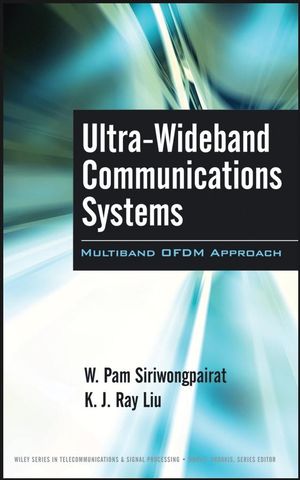Ultra-Wideband Communications Systems : Multiband OFDM ApproachISBN: 978-0-470-07469-5
Hardcover
248 pages
November 2007, Wiley-IEEE Press
 This is a Print-on-Demand title. It will be printed specifically to fill your order. Please allow an additional 10-15 days delivery time. The book is not returnable.
|
||||||
Preface xiii
Chapter 1 Introduction 1
1.1 Overview of UWB 1
1.2 Advantages of UWB 3
1.3 UWB Applications 4
1.4 UWB Transmission Schemes 5
1.5 Challenges for UWB 7
Chapter 2 Channel Characteristics 9
2.1 Large-Scale Models 10
2.1.1 Path Loss Models 10
2.1.2 Shadowing 11
2.2 Small-Scale Models 12
2.2.1 Tap-Delay-Line Fading Model 13
2.2.2 Δ− K Model 14
2.2.3 Saleh–Valenzuela Model 15
2.2.4 Standard UWB Channel Model 16
Chapter 3 UWB: Single-Band Approaches 19
3.1 Overview of Single-Band Approaches 20
3.2 Modulation Techniques 21
3.2.1 Pulse Amplitude Modulation 21
3.2.2 On–Off Keying 22
3.2.3 Phase Shift Keying 22
3.2.4 Pulse Position Modulation 23
3.3 Multiple Access Techniques 23
3.3.1 Time-Hopping UWB 24
3.3.2 Direct-Sequence UWB 25
3.4 Demodulation Techniques 26
3.4.1 Received Signal Model 26
3.4.2 Correlation Receiver 27
3.4.3 RAKE Receiver 28
3.5 MIMO Single-Band UWB 30
3.5.1 MIMO Space–Time-Coded Systems 30
3.5.2 Space–Time-Coded UWB Systems 32
3.6 Performance Analysis 37
3.6.1 TH-BPPM 38
3.6.2 TH-BPSK 41
3.6.3 DS-BPSK 42
3.7 Simulation Results 44
3.8 Chapter Summary 51
Chapter 4 UWB: Multiband OFDM Approach 53
4.1 Overview of Multiband OFDM Approach 54
4.1.1 Fundamental Concepts 54
4.1.2 Signal Model 56
4.2 IEEE 802.15.3a WPAN Standard Proposal 57
4.2.1 OFDM Parameters 57
4.2.2 Rate-Dependent Parameters 58
4.2.3 Operating Band Frequencies 59
4.2.4 Channelization 60
4.3 Physical Layer Design 61
4.3.1 Scrambler and De-scrambler 62
4.3.2 Convolutional Encoder and Viterbi Decoder 62
4.3.3 Bit Interleaver and De-interleaver 63
4.3.4 Constellation Mapper 67
4.3.5 OFDM Modulation 67
4.4 MAC Layer Design 69
4.4.1 Network Topology 69
4.4.2 Frame Architecture 71
4.4.3 Network Operations 72
4.5 Chapter Summary 73
Chapter 5 MIMO Multiband OFDM 75
5.1 MIMO-OFDM Communications 76
5.2 MIMO Multiband OFDM System Model 78
5.2.1 Transmitter Description 78
5.2.2 Channel Model 80
5.2.3 Receiver Processing 80
5.3 Performance Analysis 82
5.3.1 Independent Fading 83
5.3.2 Correlated Fading 86
5.4 Simulation Results 89
5.5 Chapter Summary 94
Chapter 6 Performance Characterization 97
6.1 System Model 98
6.2 Performance Analysis 99
6.2.1 Average PEP Analysis 100
6.2.2 Approximate PEP Formulation 102
6.2.3 Outage Probability 106
6.3 Analysis for MIMO Multiband OFDM Systems 110
6.3.1 MIMO Multiband OFDM System Model 110
6.3.2 Pairwise Error Probability 111
6.3.3 Example: Repetition STF Coding Based on Alamouti’s Structure 113
6.4 Simulation Results 114
6.5 Chapter Summary 120
Chapter 7 Performance Under Practical Considerations 121
7.1 System Model 122
7.2 Average Signal-to-Noise Ratio 124
7.2.1 Expressions of Fading Term ICI and ISI 124
7.2.2 Variances of Fading Term ICI and ISI 127
7.2.3 Average Signal-to-Noise Ratio and Performance Degradation 132
7.3 Average Bit Error Rate 132
7.3.1 Overall Spreading Gain of 1 134
7.3.2 Overall Spreading Gain of 2 136
7.3.3 Overall Spreading Gain of 4 137
7.4 Performance Bound 140
7.5 Numerical and Simulation Results 143
7.5.1 Numerical Results 143
7.5.2 Simulation and Numerical Results 145
7.6 Chapter Summary 147
Appendix: Derivations of A1 A2 B1 and B2 148
A.1 Derivation of A1 and A2 149
A.2 Derivation of B1 and B2 151
Chapter 8 Differential Multiband OFDM 155
8.1 Differential Modulation 156
8.1.1 Single-Antenna Systems 156
8.1.2 MIMO Systems 157
8.2 Differential Scheme for Multiband OFDM Systems 159
8.2.1 System Model 159
8.2.2 Differential Encoding and Transmitting Signal Structure 160
8.2.3 Multiband Differential Decoding 162
8.3 Pairwise Error Probability 163
8.4 Simulation Results 166
8.5 Chapter Summary 169
Chapter 9 Power-Controlled Channel Allocation 171
9.1 System Model 172
9.2 Power-Controlled Channel Allocation Scheme 174
9.2.1 Generalized SNR for Various Transmission Modes 175
9.2.2 PER and Rate Constraint 176
9.2.3 Problem Formulation 177
9.2.4 Subband Assignment and Power Allocation Algorithm 178
9.2.5 Joint Rate Assignment and Resource Allocation Algorithm 179
9.3 Simulation Results 182
9.3.1 Subband Assignment and Power Allocation 182
9.3.2 Joint Rate Assignment and Resource Allocation 185
9.4 Chapter Summary 186
Chapter 10 Cooperative UWB Multiband OFDM 189
10.2 System Model 191
10.2.1 Noncooperative UWB 192
10.2.2 Cooperative UWB 193
10.3 SER Analysis for Cooperative UWB 194
10.3.1 Cooperative UWB 194
10.3.2 Comparison of Cooperative and Noncooperative UWB 199
10.4 Optimum Power Allocation for Cooperative UWB 201
10.4.1 Power Minimization Using Cooperative Communications 201
10.4.2 Coverage Enhancement Using Cooperative Communications 205
10.5 Improved Cooperative UWB 208
10.6 Simulation Results 212
10.7 Chapter Summary 215
References 217
Index 227



